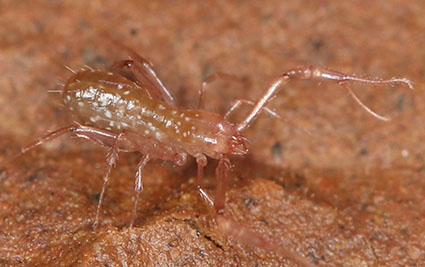Abstract
Three new pseudoscorpion species, Pseudochthonius pali sp. nov., Pseudochthonius diamachi sp. nov., and Pseudochthonius koinopoliteia sp. nov., are herein described from caves of Bahia state, Brazil. They can be distinguished from congeners mainly by the absence of eyes or eyespots, chelal and cheliceral dentition, coxal chaetotaxy and body size. Some ecological remarks on each species, possible threats, recommendations for future research and a key to the Pseudochthonius species from Brazil are provided.
References
Alvares, C.A., Stape, J.L., Sentelhas, P.C., Gonçalves, J.L.M. & Sparovek, G. (2013) Köppen’s climate classification map for Brazil. Meteorologische Zeitschrift, 22 (6), 711–728. https://doi.org/10.1127/0941-2948/2013/0507
Assis, L.D., Schimonsky, D.M.V. & Bichuette, M.E. (2021) The first troglobitic Pseudochthonius Balzan, 1892 (Pseudoscorpiones, Chthoniidae) from the karst area of Serra do Ramalho, Brazil: a threatened species. Subterranean Biology, 40, 109–128. https://doi.org/10.3897/subtbiol.40.77451
Auler, A. (2019) Histórico, ocorrência e potencial de cavernas no Brasil. In: Rubbioli, E., Auler, A., Menin, D. & Brandi, R., Cavernas: Atlas do Brasil Subterrâneo. ICMBio, Brasília, pp. 290.
Beier, M. (1969) Ein wahrscheinlich troglobionter Pseudochthonius (Pseudoscorp.) aus Brasilien. Revue Suisse de Zoologie, 76 (1) 1–2. https://doi.org/10.5962/bhl.part.97044
Beier, M. (1970) Myrmecophile Pseudoskorpione aus Brasilien. Annalen des naturhistorischen Museums in Wien, 74, 51–56.
Benavides, L.R., Cosgrove, J.G., Harvey, M.S. & Gonzalo, G. (2019) Phylogenomic interrogation resolves the backbone of the Pseudoscorpiones tree of life. Molecular Phylogenetics and Evolution, 139, 106509. https://doi.org/10.1016/j.ympev.2019.05.023
Chamberlin, J.C. (1929) The genus Pseudochthonius Balzan (Arachnida—Chelonethida). Bulletin de la Société Zoologique de France, 54, 173–179.
Chamberlin, J.C. (1931) The arachnid order Chelonethida. Stanford University Publications. Biological Sciences, 7, 1–284.
Ferreira, R.L., Bernard, E., Júnior, F.W.C., Piló, L.B., Calux, A., Souza-Silva, M., Barlow, J., Pompeu, P.S., Cardoso, P., Mammola, S., García, A.M., Jeffery, W.R., Shear, W., Medellín, R.A., Wynne, J.J., Borges, P.A.V., Kamimura, Y., Pipan, T., Hajna, N.Z., Sendra, A., Peck, S., Onac, B.P., Culve, D.C., Hoch, H., Flot, J., Stoch, F., Pavlek, M., Niemiller, M.L., Manchi, S., Deharveng, L., Fenolio, D., Calaforra, J., Yager, J., Griebler, C., Nader, F.H., Humphreys, W.F., Hughes, A.C., Fenton, B., Forti, P., Sauro, F., Veni, G., Frumkin, A., Gavish-Regev, E., Fišer, C., Trontelj, P., Zagmajster, M., Delic, Teo., Galassi, D.M.P,. Vaccarelli, I., Komnenov, M., Gainett, G., Tavares, V.C., Kováč, L., Miller, A.Z., Yoshizawa, K., Di Lorenzo, T., Moldovan, O.T., Sánchez-Fernández, D., Moutaouakil, S., Howarth, F., Bilandžija, H., Dražina, T., Kuharić, N., Butorac, V., Lienhard, C., Cooper, S.J.B., Eme, D., Strauss, A.M., Saccò, M., Zhao, Y., Williams, P., Tian, M., Tanalgo, K., Woo, K., Barjakovic, M., Mccracken, G.F., Simmons, N.B., Racey, P.A., Ford, D., Labegalini, J.A., Colzato, N., Pereira, M.J.R., Aguiar, L.M.S., Moratelli, R., Du Preez, G., Pérez-González, A., Reboleira, A.S.P.S., Gunn, J., Mc Cartney, A., Bobrowiec, P.E.D., Milko, D., Kinuthia, W., Fischer, E., Meierhofer, M.B. & Frick, W.F. (2022) Brazilian cave heritage under siege. Science, 375, 1238–1239. https://doi.org/10.1126/science.abo1973
Cole, M.M. (1960) Cerrado, caatinga and pantanal: the distribution and origin of the savanna vegetation of Brazil. The Geographical Journal, 126 (2), 168–179. https://doi.org/10.2307/1793957
Harms, D. (2018) The origins of diversity in ancient landscapes: deep phylogeographic structuring in a pseudoscorpion (Pseudotyrannochthoniidae: Pseudotyrannochthonius) reflects Plio-Pleistocene climate fluctuations. Zoologischer Anzeiger, 273, 112–123. https://doi.org/10.1016/j.jcz.2018.01.001
Harvey, M.S. (1988) The systematics and biology of pseudoscorpions & N. W. Heather. Australian Arachnology. Australian Entomological Society, Brisbane, pp. 75–85.
Harvey, M.S. (1992) The phylogeny and classification of the Pseudoscorpionida (Chelicerata: Arachnida). Invertebrate Taxonomy, 6, 1373–1435. https://doi.org/10.1071/IT9921373
Harvey, M.S. (2013) Pseudoscorpions of the World. Version 3.0. Western Australian Museum. Perth. Available from: http://www.museum.wa.gov.au/catalogues/pseudoscorpions (accessed 26 November 2021)
Hoff, C.C. (1946) Three new species of heterosphyronid pseudoscorpions from Trinidad. American Museum Novitates, 1322, 1–13.
IUCN (2017) Guidelines for using the IUCN Red List categories and criteria. Version 13. Available from: https://iucnredlist.org/resources/redlistguidelines (accessed 26 January 2023)
Mahnert, V. (2001) Cave-dwelling pseudoscorpions (Arachnida, Pseudoscorpiones) from Brazil. Revue Suisse de Zoologie, 108 (1), 95–148. https://doi.org/10.5962/bhl.part.79622
Montesanto, G. (2015) A fast GNU method to draw accurate scientific illustrations for taxonomy. ZooKeys, 515, 191–206. https://doi.org/10.3897/zookeys.515.9459
Muchmore, W.B. (1970) An unusual Pseudochthonius from Brazil (Arachnida, Pseudoscorpionida, Chthoniidae). Entomological News, 81, 221–223.
Schimonsky, D.M.V., Gallão, J.E. & Bichette, M.E. (2022) A new troglobitic Pseudochthonius (Pseudoscorpiones: Chthoniidae) from Minas Gerais State, south-east Brazil. Arachnology, 19 (1), 38–46. https://doi.org/10.13156/arac.2022.19.1.38
Souza, M.F.V.R. & Ferreira, R.L. (2010) Eukoenenia (Palpigradi: Eukoeneniidae) in Brazilian caves with the first troglobiotic palpigrade from South America. Journal of Arachnology, 38, 415–424. https://doi.org/10.1636/Ha09-112.1
Souza-Silva, M., Cerqueira, R.F.V., Pellegrini, T.G. & Ferreira, R.L. (2021) Habitat selection of cave-restricted fauna in a new hotspot of subterranean biodiversity in Neotropics. Biodiversity and Conservation, 30, 4223–4250. https://doi.org/10.1007/s10531-021-02302-8
Vasconcelos, A.C.O. & Ferreira, R.L. (2017) Two new species of cave-dwelling Charinus Simon, 1892 from Brazil (Arachnida: Amblypygi: Charinidae). Zootaxa, 4312 (2), 277–292. https://doi.org/10.11646/zootaxa.4312.2.4
Viana, A.C.M., Souza, M.F.V.R. & Ferreira, R.L. (2018) Spelaeobochicha goliath (Arachnida: Pseudoscorpiones: Bochicidae), a new troglobitic pseudoscorpion from Brazil. Zootaxa, 4402 (3), 585–594. https://doi.org/10.11646/zootaxa.4402.3.11
World Pseudoscorpiones Catalog (2022) World Pseudoscorpiones Catalog. Natural History Museum Bern. Available from: http/wac.nmbe.ch (accessed 7 December 2022)
Wynne, J.J., Francis, G.H., Stefan, S. & Brett, G. (2019) Fifty years of cave arthropod sampling: techniques and best practices. International Journal of Speleology, 48, 33–48. https://doi.org/10.5038/1827-806X.48.1.2231


